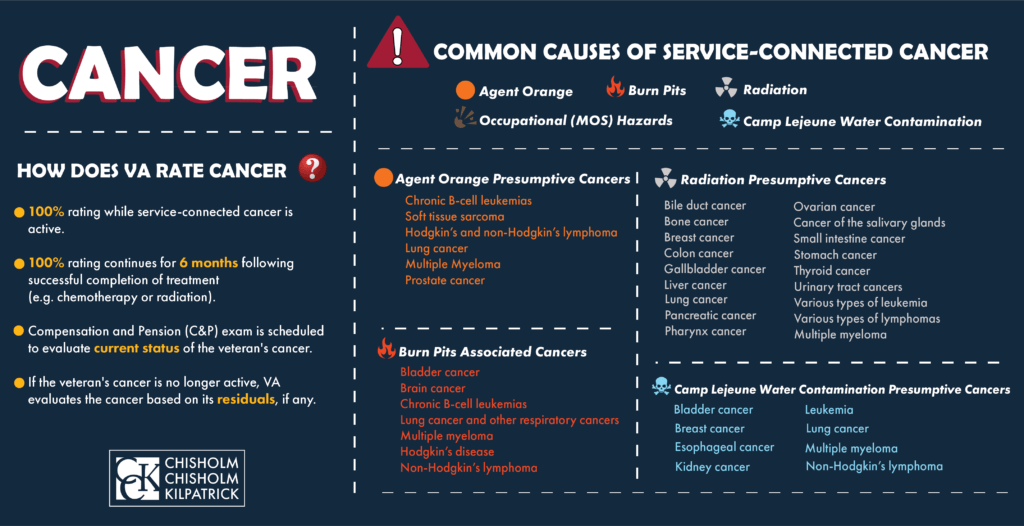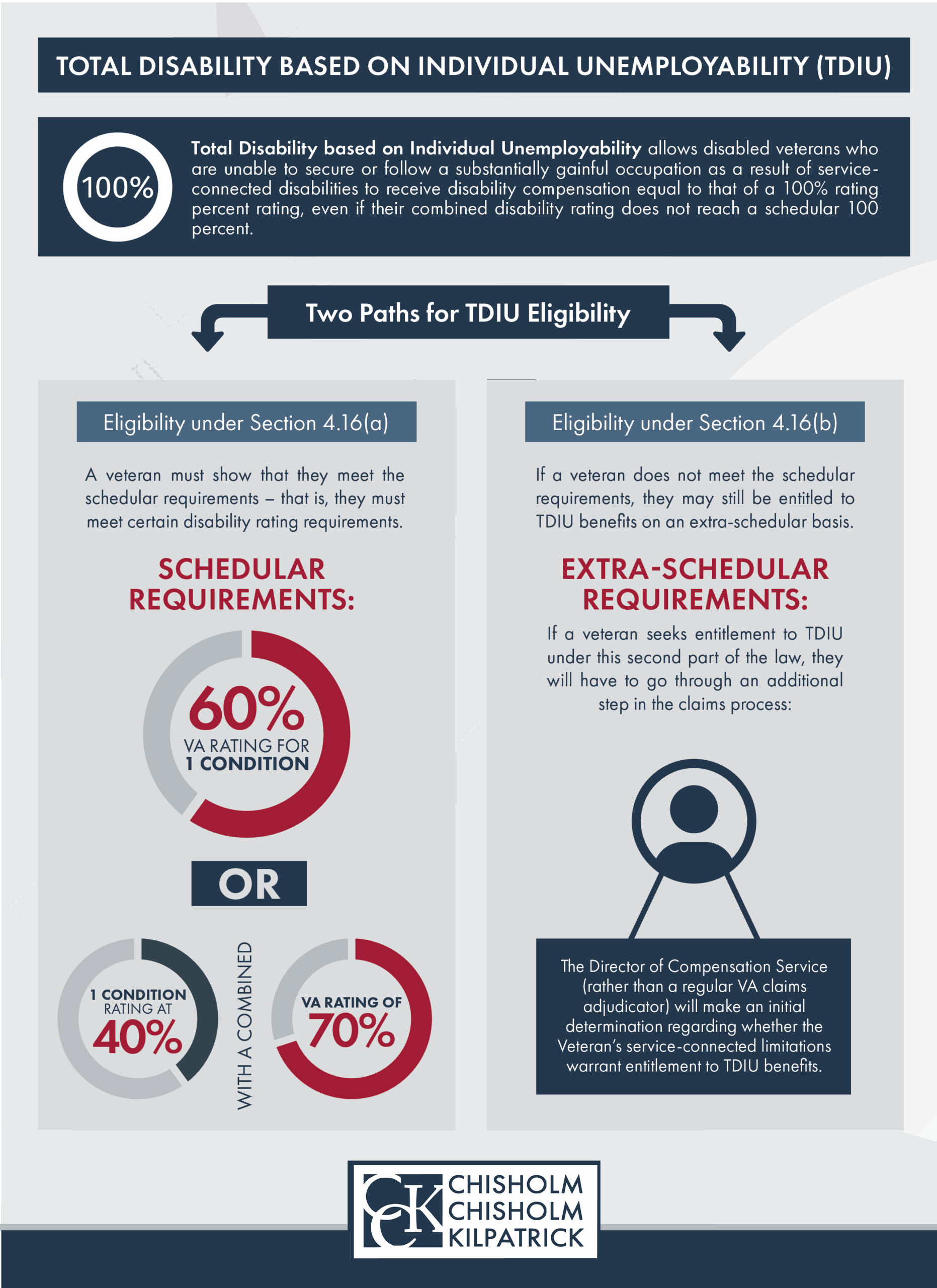Prostate Cancer VA Disability Rating and Compensation

CCK Law: Our Vital Role in Veterans Law
Many veterans suffer from prostate cancer due to their time in military service. VA offers service-connected compensation to these veterans based on active cancer or the presence and severity of the cancer residuals.
What is Prostate Cancer?
Cancer occurs when cells in the body grow out of control. Prostate cancer occurs when the cells grow out of control in the prostate gland specifically. The prostate gland is below the bladder and behind the seminal vesicles, which make most of the fluid for semen. The prostate also “makes some of the fluid that is part of semen.”
Nearly all forms of prostate cancer are adenocarcinomas. Adenocarcinomas can develop from gland cells. There are multiple types of other cancers that may start in the prostate, however, including small cell carcinomas, neuroendocrine tumors, transitional cell carcinomas, and sarcomas. Often, prostate cancer grows slowly, but some forms may grow quickly and spread.
Symptoms of Prostate Cancer
- Difficulty urinating, specifically increased urge to urinate or weak urinary stream
- Bloody urine or semen
- Erectile dysfunction
- Hip, back, or chest pain
- Weakness or numbness
- Loss of bladder or bowel control

Diagnosing and Treating Prostate Cancer
Certain factors could make a person more susceptible to developing prostate cancer. These factors can include age, ethnicity, geography, family history, or genetic changes. Other risk factors can include exposure to certain chemicals and toxic substances, like Agent Orange.
Prostate cancer can usually be found through screening. Early prostate cancer usually does not cause symptoms, so screening can be crucial for detection.
Tests to detect and diagnose prostate cancer can include:
- Physical examination
- PSA blood test
- Prostate biopsy
- Imaging tests
- Genetic testing
- Transrectal ultrasound
- MRI
- PET scan
- Bone scan
- CT scan
Treatments may vary depending on the severity of the cancer, as well as the age and overall health of the individual. These treatment methods could include:
- Surgery
- Radiation therapy
- Cryotherapy
- Hormone Therapy
- Chemotherapy
- Immunotherapy
- Targeted therapy
How Does VA Rate Prostate Cancer?
Upon establishing service connection, VA rates prostate cancer depending on if it is active. If the cancer is active, VA should automatically assign a 100% disability rating. If the cancer goes into remission, VA will evaluate each residual of the cancer and rate them based on the severity.
These are some common residuals of prostate cancer and their ratings.
- Frequent urination. The rating criteria for urinary frequency range from 10 to 40 percent disabling, depending on the amount of time between voiding. The 10% rating requires “daytime voiding interval between two and three hours, or; awakening to void two times per night.” To qualify for the 40% rating, there must be “daytime voiding interval less than one hour, or; awakening to void five or more times per night.”
- Urinary Incontinence. Urinary incontinence is rated under Voiding Dysfunction and includes ratings from 20% to 60% disabling. The ratings are dependent on how often a veteran needs their absorbent materials changed due to their incontinence. Absorbent materials include adult diapers or pads, and to be eligible or the 60% rating, absorbent materials must be changed four or more times per day.
- Erectile Dysfunction. Erectile dysfunction is a common residual of prostate cancer. VA will only grant 0% for erectile dysfunction unless there is a deformity with loss of erectile power. However, a grant of service connection for erectile dysfunction deems a veteran eligible for Special Monthly Compensation (SMC) for the loss of use of a creative organ. As of December 1, 2024, SMC (k) amounts to $136.06 a month.
These are just a few common residuals, and some veterans may experience additional residuals. Presence and severity vary from person to person.

Exposure and Prostate Cancer
Various forms of exposure that veterans have faced during their service have been linked to prostate cancer. Some forms of exposure do have presumptive service connection, while others do not. Therefore, depending on the form of exposure, some veterans may have an easier time becoming service-connected than others.
Agent Orange Exposure and Prostate Cancer
Agent Orange is one of several herbicides, or “rainbow herbicides,” that were used during the Vietnam War era. Specifically, Agent Orange was a mixture of two different kinds of highly toxic chemicals: 2, 4-D and 2, 4, 5-T. The highly toxic dioxin contaminant known as 2, 3, 7, 8-TCDD is a byproduct produced by Agent Orange. Many veterans came into contact with Agent Orange, including those who served in areas other than Vietnam.
Veterans who were exposed to Agent Orange and developed prostate cancer are entitled to presumptive service connection, so long as they are able to prove they served in qualifying locations and time periods. Specifically, these veterans do not have to prove a connection between their prostate cancer and military service to be eligible to receive VA health care and disability compensation
In regard to Agent Orange exposure, VA has established a presumption of exposure for the following locations and time periods:
- Vietnam between January 9, 1962 and May 7, 1975 – this only includes veterans who were boots-on-the-ground in Vietnam, or veterans with service aboard a ship that operated in the inland waterways of Vietnam, made visits ashore, and Blue Water Navy veterans.
- In or near the Korean demilitarized zone (DMZ) between September 1, 1967 and August 31, 1971.
Military Burn Pit Exposure
Military burn pits are large areas of land in which the military and its contractors incinerate all waste generated by military bases, including plastics, medical waste, rubber, human waste, and more.
The U.S. Military used burn pits as part of their waste disposal protocol in places such as Iraq and Afghanistan in the post-9/11 era during Operations Iraqi and Enduring Freedom. While the practice was effective in reducing large quantities of waste, burn pits emitted plumes of toxic smoke. This was especially problematic in places such as the Middle East, as the desert wind carried the smoke for miles.
Many U.S. Military veterans have suffered health consequences due to burn pit exposure. Most of the negative effects involve temporary ailments of the respiratory system, though limited evidence suggests a link between burn pit exposure and the long-term deterioration of lung health.
These burn pits were used extensively throughout the Middle East and have affected veterans who served in Operation Iraqi Freedom, Operation Enduring Freedom, and Operation New Dawn.
Research continues to be done to link burn pit exposure to a variety of different conditions, such as cancers and respiratory conditions. While further research will need to be conducted, it has been indicated that one of the known chemical compounds, which was found in Agent Orange, called TCDD, was also released by burn pits.
While VA does acknowledge certain conditions as being eligible for presumptive service connection if the veteran can prove exposure to Agent Orange, VA has not established a presumption for veterans exposed to burn pits. Since there is no presumption, VA adjudicates burn pits claims on a case-by-case basis.
VA does not have a consistent approach to deciding these claims, so lay evidence from veterans is key to winning burn pit claims. Often, VA does not have a way of proving veterans were near burn pits, so statements from the veteran or buddy statements can help to verify exposure.
New Proposed Burn Pit Legislation 2021
As of 2021, there are several major bills currently pending in Congress, that deal with the toxic exposure caused by burn pits. These bills include:
- Conceding Our Veterans’ Exposure Now and Necessitating Training Act (COVENANT)
- Presumptive Benefits for War Fighters Exposed to Burn Pits and Other Toxins Act of 2021
- Veterans Burn Pit Exposure Recognition Act
- Toxic Exposure in the American Military Act (TEAM)
Any of these bills, if passed, would offer much-needed relief to veterans suffering the toxic effects of burn pit exposure. Specifically, the COVENANT Act would make any form of reproductive cancer presumptive. Essentially, this means that the burden of proof would no longer be on the veteran to demonstrate the link between military burn pit exposure and prostate cancer.
Is Prostate Cancer Presumptive?
Yes…and no. As mentioned above, prostate cancer is a presumptive condition for veterans exposed to Agent Orange. “Presumptive” means that veterans do not have to provide a nexus (a link between their condition and service) to prove service connection.
Veterans who were exposed to burn pits in the Southwest theatre of operations after September 11, 2001, have also gone on to develop prostate cancer. While VA does not acknowledge disabilities as presumptively caused by burn pits, veterans can provide a nexus opinion from a medical professional to argue for service connection for their prostate cancer.
Denied VA Disability Benefits for Prostate Cancer?
VA disability claims for prostate cancer, specifically stemming from exposure to military burn pits, may be denied by VA because there is no presumption of exposure. However, if your claim for prostate cancer was denied, you still have options for appealing the decision.
The accredited VA disability attorneys at CCK may be able to help you secure VA disability benefits for your prostate cancer. Contact our office today for a free case evaluation at (800) 544-9144 with a member of our team.
About the Author
Share this Post



